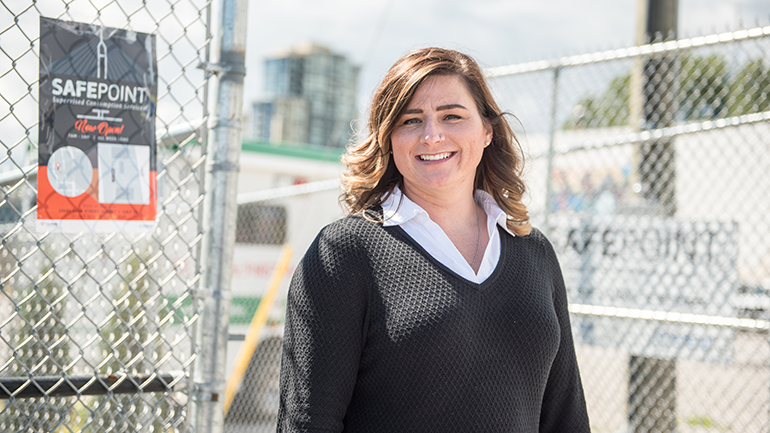
Erin Gibson, Harm Reduction Coordinator, Central City, fights against both drug overdose and stigma.
It was the height of the fentanyl epidemic, and Harm Reduction Coordinator Erin Gibson was about to deliver an emergency information session in the heart of Surrey’s homeless community when she heard a scream for help: “Overdose!”
She and a shelter worker sprinted toward the sound and found a man not breathing on the ground. As Erin gave him CPR, the employees administered Naloxone to try to reverse the drug’s effects as they waited for paramedics.
Forty-three people were treated for overdose at Surrey Memorial Hospital that July 2016 weekend, the result of a batch of drugs containing fentanyl – a synthetic opioid 50 to 100 times more toxic than morphine. The sudden overdose surge came just months after B.C. declared a provincial public health emergency.
“Erin saved lives that night, and she continues to do so through her work,” said Sherry Baidwan, Manager of Harm Reduction Programs. “She is extremely dedicated and what she gives of herself far exceeds expectation. She is a true hero.”
Erin first joined Population and Public Health in 2012. Due in large part to her influence, today, harm reduction is central to Fraser Health’s philosophies and practices in caring for people who use drugs.
“Three years ago, harm reduction was either unfamiliar or misunderstood by many Fraser Health employees,” said Population and Public Health policy analyst Tobie Patterson. “Through Erin’s training and efforts, there has been a substantial shift in the culture to the point where many employees now see harm reduction as an integral part of our services.”
Over the past five years, Erin’s built community partnerships to mobilize services and support for marginalized people who use substances. In fact, through her workshops and outreach she and teams of Fraser Health employees enabled the distribution of more than 800 Take Home Naloxone kits in the past year.
“I truly do not have the words to explain my admiration for Erin and her work,” said Salman Klar, a Public Health Observatory epidemiologist. “I do know if Erin was not in her position, we would not be at this point with our overdose response and harm reduction.”
Fraser Health’s overdose response has ramped up as the crisis has deepened – 967 people died of overdoses in 2016; 876 have died as of July 2017. Fraser Health opened six overdose prevention sites since December 2016, followed by two supervised consumption sites in June 2017 – at SafePoint on 135A in Surrey and Quibble Creek Sobering and Assessment Centre. Since then, SafePoint alone has served more than 600 individual clients who have visited nearly nine thousand times and staff there have helped reverse 147 overdoses, with no loss of life. Opioid Agonist Treatment is now being expanded across the region, with more than 600 people served to date and a second harm reduction coordinator was hired in January.
Meanwhile, Erin has taught more than a thousand employees how to recognize and respond to overdoses. She’s a fixture at public education forums and attends municipal meetings on her own time as an advocate for people at risk of overdoses
In addition to overdose prevention training, Erin holds sessions to address the stigma people who use substances face in accessing health services and she works with Fraser Health teams and partners to include people in decisions about their care and create a more accessible, responsive health care model.
“Unless you pull that apart,” she said of ingrained prejudices, “it’s going to show up in the work you do, and in the way you provide health care. A lot of times the voices of people who use substances are erased. Bringing people’s voices in is a powerful way to change perceptions and create meaningful interventions that are going to work.”
Erin stressed that her work is only a small part of the enormous effort being made by dozens of individuals in and outside Fraser Health, including municipalities, first responders and social agencies, to intervene in the overdose crisis and save lives.
“We know people are dying so we’re all just trying to do better, faster,” she said. “Harm reduction has been called a radical form of love and we could all use more of that.”
